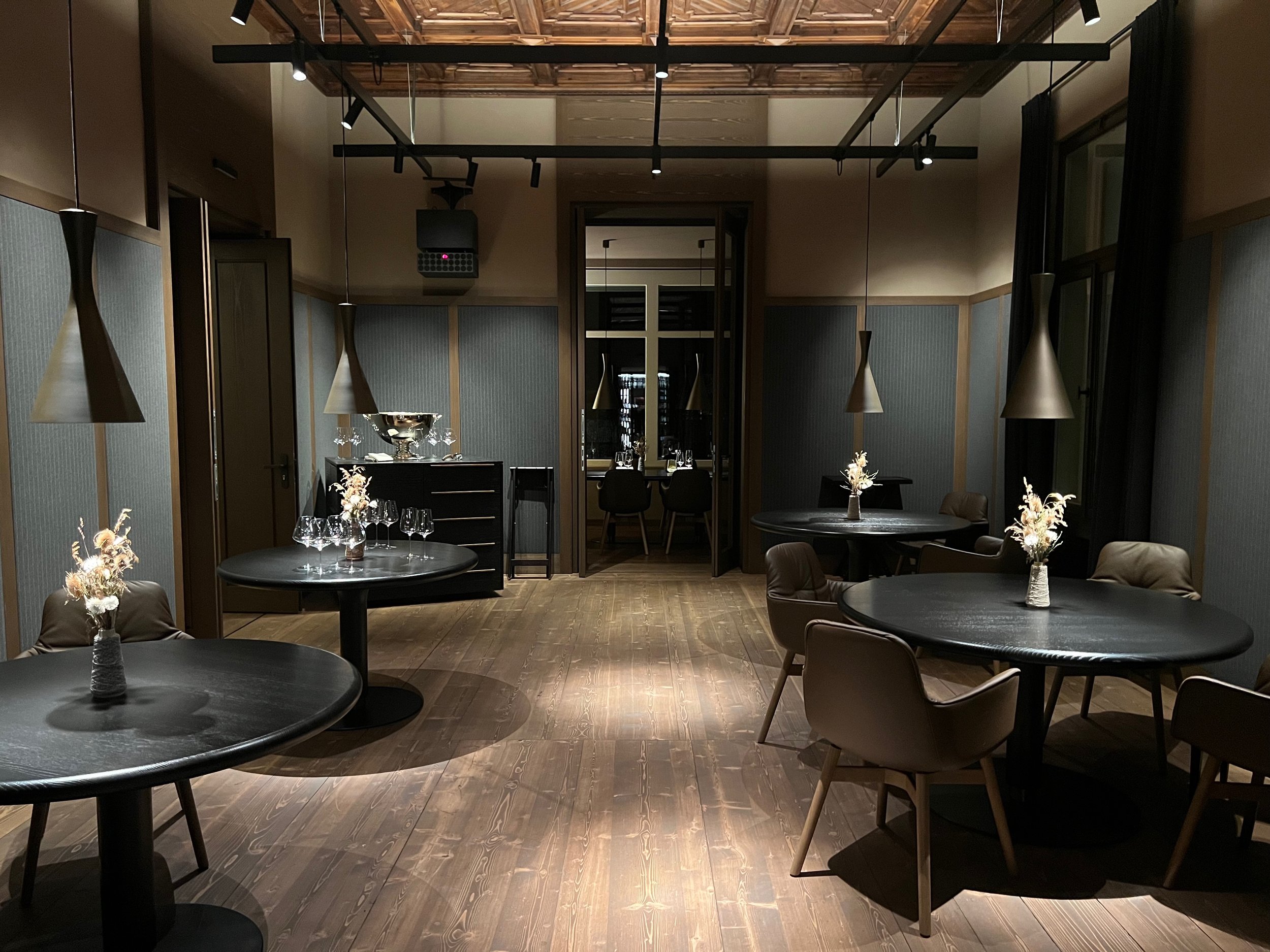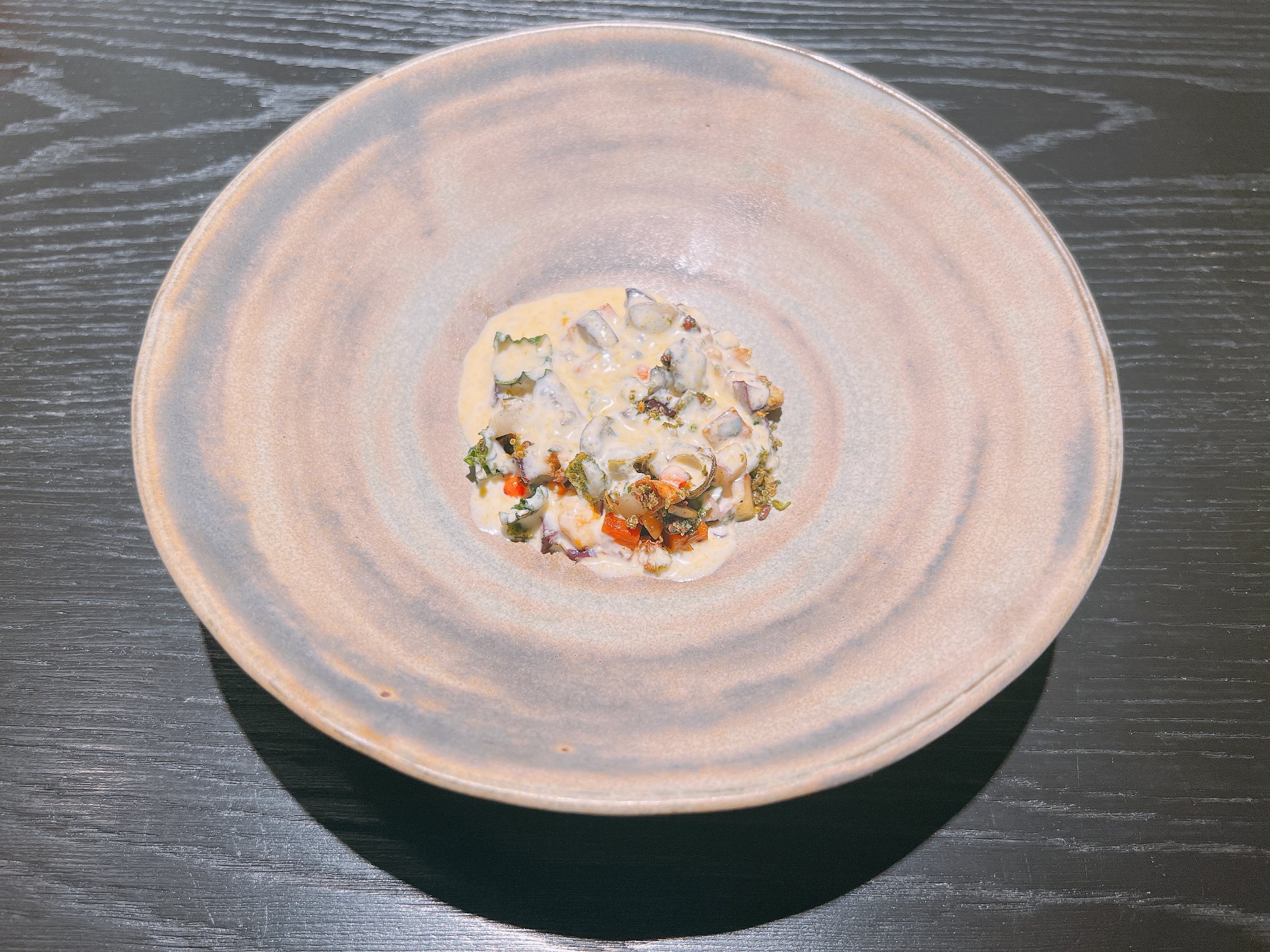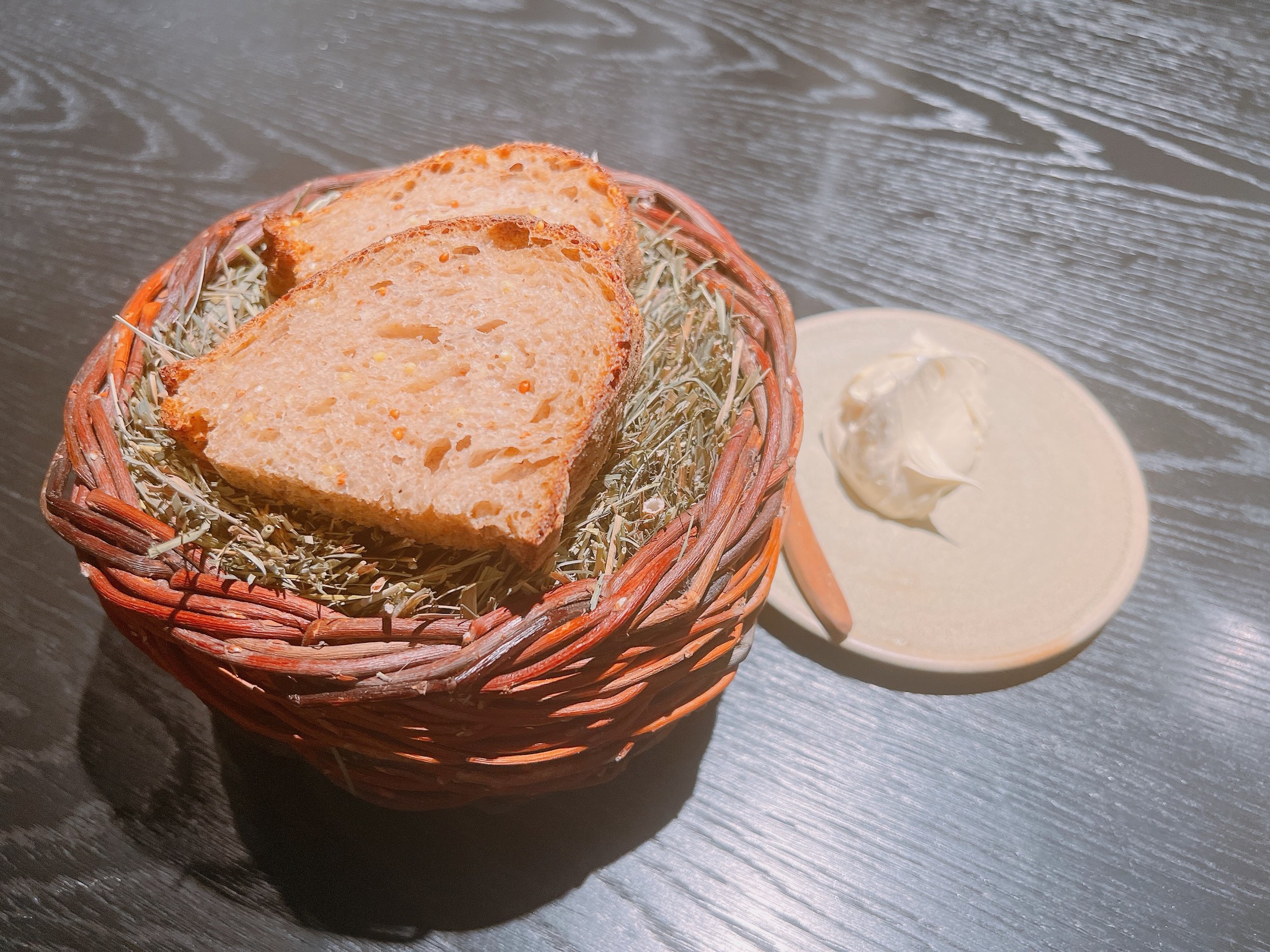Atelier Moessmer Norbert Niederkofler - Brunico
Rating: 17/20
Where: Brunico, Italy
When: Dinner for 2 on 7 December 2023
Cost per Person: Tasting menu 290 Euro, Wine pairing 180 Euro
Accolades: 3 Michelin Stars
Why: Local, seasonal cuisine from the Italian Alps
“Atelier Moessmer - Norbert Niederkofler” might not be the pithiest name for a restaurant, but it is certainly descriptive. “Moessmer” refers to one of the largest fabric producers in the world, and the restaurant is situated on the company’s premises in the small town of Brunico in north-eastern Italy, not far from the Austrian border. In fact, it’s inside the villa that was previously the home of the company’s CEOs. The restaurant’s chef is (unsurprisingly) Norbert Niederkofler, who until recently helmed the three-starred St. Hubertus, about a 45 minute drive south. St. Hubertus unfortunately closed in early 2023 for a multi-year renovation of the hotel that it was located in. Having some advance notice, chef and staff were able to move the whole operation, and just a few months after opening, Michelin bestowed three stars on the new restaurant.
The closest major airport to Brunico is Innsbruck in Austria, which is about a 1 1/2 hour drive away, all on major roads. And in an ideal world, that would have been our travel route. But instead, our flight to Innsbruck developed engine problems on the runway and was subsequently canceled. We booked a new flight to Venice, which then had another two hour delay due to staffing shortages at Frankfurt airport. This meant we got to “enjoy” a four-hour middle-of-rush-hour race on northern Italy's dark, winding, icy roads. Following this nail-biter, we arrived at our destination nine hours delayed, with only five minutes to spare before the last seating time at 8:30pm. It felt like being on “The Amazing Race - Michelin Edition” - soon coming to a station near you!
Atelier Moessmer is located in a residential neighborhood, and Google Maps encouraged us to drive through some poor person's front yard. After finding a more reasonable (and more legal) route, we parked in the factory's parking lot. From there, it was past a small gate, up some stairs, and finally time to press the doorbell on an unmarked door. Welcomed into a lounge with comfortable, low-slung chairs, we finally were able to relax for the first time in twelve hours. It turned out that this was one of two rooms where guests were able to enjoy aperitifs and amuse bouches before being led to their seats - either in a traditional dining room (see above) or at the chef's counter surrounding the open kitchen (see below). Petit fours, tea, coffee and the unavoidable check were again served in the lounge. If the sequence of unmarked door, doorbell, and journey through lounge and dining room seems somehow familiar, then it’s probably no surprise that chef Niederkofler is a big fan of restaurant Frantzén.
It turned out that the surroundings were the most obvious change from the restaurant's more rustic predecessor St. Hubertus. The menu still followed the “all seasonal, all local” mantra called “cook the mountain”, and the resulting food is more or less the same as before. Well, with some small tweaks: while St. Hubertus was open only during summer and winter (restricted by its hotel's opening times), Atelier Moessmer serves dinner year-round, and consequently has new menus for spring and fall. Thus, we were one of the first (few hundred) guests able to sample the chef's new fall menu.
A single tasting menu was served to all diners, but most dietary restrictions were accommodated. On our visit, there were also three supplemental courses on offer, all classics of the restaurant. We tried the two savory additions, but had to declare defeat when it came to the otherwise great sounding tarte tartin - this ended up being a lot of food. A beverage pairing was available as well, consisting mostly of wines (some of them local), but also including a beer and an apple cider. The wines were pretty good (but not necessarily outstanding), and for some courses two wines were served, allowing for interesting comparisons on what went better with the food. Recommended.
Our dinner started with some small bites that were paired with a decent local sparkling wine. A beet tartlet was filled with grapes, duck speck and a hollandaise-like sauce. Every ingredient had its purpose in this dish: the beets contributed a bit of sweetness, pickles provided acidity and the hollandaise added a creamy texture. Add the tasty speck, and you had an excellent start to our meal 19.
A cannoli was made from thinly sliced potatoes that had been rolled into a tube shape. It was filled with goat cheese seasoned with herbs and mushrooms. An ostensibly simple, but very tasty dish. The filling reminded me of a thick herb quark, sometimes seen as an accompaniment to fried potatoes - so this dish had the same ingredients in a different combination. Maybe a bit heavy, but very good 18.
Next, we received two chickpea tartlets. Mine (the standard dish) was topped with a “pastin” of veal (similar to a roasted sausage), an egg yolk emulsion and hempseeds. The tartlet base was quite soft, and the flavors of this dish were a bit subdued - nothing really stood out. Maybe adding some acidity would have allowed the ingredients to shine more 16. The pescatarian alternative was topped with a shallot cream and shaved cheese. Nicely creamy and cheesy, but overall a bit too dry for my taste 16.
Another vaguely Mexican-inspired dish were corn tacos filled with char tartare, char roe and apples. This taco was definitely crunchy, and the char had a nicely smoky flavor. It was the lightest among the four initial bites 17.
After the flight of amuse bouches, we were taken on a tour of the restaurant's new premises, and finally ended up seated at the kitchen counter. Our first “real” course arrived soon thereafter: an autumnal salad made from seasonal vegetables, salads, crispy seeds and a yogurt sauce made with fermented garlic. Due to the season, most vegetables were root vegetables with textures ranging from crunchy to soft. The seeds added some more crunch, and the yogurt sauce was nicely creamy, maybe veering a tad too much into the mayonnaise direction, which made the dish a bit heavier than it might otherwise have been. An earthy fall dish. My only regret was that this was not the even better summer salad that we had previously had at St. Hubertus. I guess we need to come back some other time of the year 18.
Along with the salad came a brioche seasoned with onions. Very flaky and crunchy, its texture was actually closer to a croissant than a brioche. But nitpicking on naming aside, it was a nice accompaniment with a bit of sweetness thanks to the onions 17.
Next: a trout tartare that had been cold smoked and hot smoked in succession, before being topped with trout roe and some pickles. It was paired with a broth made from the “not so noble” parts of the fish - bones and such. This sauce followed the restaurant’s goal of not letting any parts of the produce go to waste. Some basil oil completed the dish. The fish was nicely smoky and had a strong flavor. Its consistency was very tender - similar to what a trout cooked sous vide would have been like. (Eschewing “too” modern preparation techniques, the kitchen doesn't actually cook anything sous vide.) The pickles added some welcome crunch, and the sauce was elegant, striking a perfect balance of being neither too heavy nor too light 18.
The next course caused us a bit of deja vu. White fish tartare was topped with crunchy pieces of fish skin, and served with a sauce made from local white wine, the “less noble” parts of the fish, and basil oil. At first we were puzzled by the similarity between this dish and the previous course. But it turned out that this was one of the two signature dishes that we had added to our tasting menu. Still, it's a bit weird to offer a supplemental dish that's so similar to one already on the menu - and immediately after it, no less. Well, it turns out that this was my only complaint about this dish. As opposed to the previous trout, the white fish dish was served warm, which enhanced all flavors, especially of the sauce. The white fish was more meaty than the trout, and the skin added some good crunch. A lovely dish, full of flavors, deservedly a signature dish 19+.
Bread made with local seeds and miso was served with a salted, whipped local butter. The bread had a nicely crunchy crust, and tasted a bit nutty, maybe thanks to the seeds. The butter was also very good, and went well with the slightly warm bread 17.
A risotto came with goat cheese, sunchokes, hazelnuts and crumbles of veal black pudding on top. The rice was cooked very al dente, with a distinct bite to it and an almost mealy texture inside. It was a texture that you either loved (me) or hated (my wife) - well, at least it wasn't boring. The autumnal, creamy sauce went well with the rice, although I couldn't taste the sunchokes. Curiously, I liked the pescatarian version (without the black pudding) better than the original. The black pudding had made this dish much heavier (something a risotto usually doesn't need) 17 (18 without the black pudding).
The second signature dish that we had added were beet gnocchi filled with a horseradish sauce. Schüttelbrot crumbles and a dollop of daikon cream were also on the plate. I thought it interesting that horseradish, often a condiment on the side, was inside the gnocchi, while daikon, usually inherently part of a dish, ended up being the condiment. The gnocchi were lightly sweet and a bit (too) doughy. Sadly, the horseradish flavor was very light - I would have preferred more of a punch 17.
Veal tongue had been marinated in red wine, and then bbq'ed in its own fat. On top was a chutney of local roots and mustard seeds. On the side: some mustard seasoned with local honey and topped with shredded horseradish. This was a heavy, meaty, wintry dish. In fact, somewhat too heavy for my taste. The mustard seeds added a bit of acidity, but that wasn't enough to counter the dish’s overall heaviness. Not my favorite 15. Much better was a cup of broth on the side that was made from vegetables left over from the salad course served earlier. Seasoned with chive oil it was full of flavor and umami and very tasty 18.
The pescatarian replacement for the veal tongue was a celeriac steak that was first cooked, then grilled, and finally topped with mushrooms, lemon-thyme honey and local seeds. The sauce surrounding it was made from the unused parts of celeriac, yeast from the bread, and lemon-thyme oil. A nice sauce, but the celeriac itself was a bit boring: not very flavorful, it tasted only a bit nutty thanks to the seeds 14.
For the final savory course, I received a lamb prepared two ways. Two pieces of lamb steak were excellent, full of flavor and tender (19 by themselves). They were served with a dollop of mole and some salsify. I liked the slight acidity of the mole, but the salsify was a bit nondescript. Some more lamb rolled up into a lollipop crusted with sesame seeds was ok, but much less flavorful than the steaks (maybe a 16). A ravioli was filled with the “less noble” parts of cabbage - tasty, but a bit salty (17). Overall, mostly thanks to the excellent steaks 17.
I liked the pescatarian alternative to the lamb a bit better. Char fish had been grilled (charred?) over fire, and came with a salsify cream sauce made with koji. A fish ball on the side was oddly reminiscent of sausage or possibly chicken, with a crunchy seedy shell and a peppery aftertaste. Quite nice. With the tasty sauce and the nicely cooked fish this made for a lovely dish 18.
The first dessert was based on apples: baked apples, crumbles, apple sorbet and an apple “popcorn” that instantly melted in one's mouth. The sorbet was quite sweet with a pronounced baked apple flavor. Altogether not bad, but maybe a bit of a single-note dish 17. It was paired with an apple wine that was much too dry for the very sweet dessert - an unfortunate choice.
Dessert number two was a play on a Linzer torte. A biscuit lattice made with hazelnuts and juniper covered a red fruit sorbet, some red currants, and dollops of hazelnut/juniper cream. Mixed all together (as instructed to by our server), we were reminded of a fruity tart, with some nutty baked pieces. Ok, but a far cry from an actual Linzer torte 14.
Back to the lounge, we were treated to four petit fours. A “Monte Rocher” was a play on a Ferrero Rocher, using nuts and hay (sic!) while avoiding the use of chocolate. It was creamy, nutty and not too sweet. However, I'd still prefer the original 15. An apple jelly (think: pate de fruit) was fine, and felt autumnal 14. A “diplomatica” (traditionally a vanilla cake) was made with mountain honey. This was a light dessert with a hint of an herbal flavor 14. Finally, a “mont blanc” made with chestnuts and cherries was mealy and heavier than the other bites, with a touch of umami 14.
Overall: A mostly delightful journey through local seasonal cooking in the Italian Alps, with excellent service throughout in a welcoming modern environment. The new fall menu made use of current produce while avoiding the preserved ingredients that a winter menu would rely on. Unfortunately, that also meant that flavors were a bit more subdued overall, and (for lack of acidity) led to a heavier-seeming menu. Compared to the 2022 summer menu at St. Hubertus, which I enjoyed quite a lot, this was a small step down 17.

























